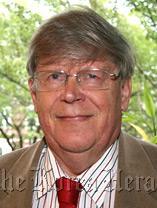[Herald Interview] Expert calls for safeguards on N.K. reactor
By 천성우Published : April 21, 2011 - 18:56
Ex-IAEA deputy director concerned by danger of possible radiation leak at Yongbyon
The light water reactors being built in Yongbyon, North Korea, will not be a danger as long as IAEA safeguard measures are properly in place, a nuclear expert said.
The remarks came from Olli Heinonen, former deputy director general of the International Atomic Energy Agency until last year, in an e-mail interview with The Korea Herald. In a recent interview with Radio Free Asia, he was quoted as saying that a light water nuclear reactor the North is building had a higher risk of causing radiation leak than its existing nuclear facilities. His remarks may fuel worries around the peninsula.
Regarding South Korean people’s concerns about North Korea’s construction of light water reactors, Heinonen did not deny the possibility of danger.
“The Democratic People’s Republic of Korea (North Korea) has at the reprocessing plant a substantial amount of high-level radioactive waste of which storage conditions are not known. It is likely that North Korea has not yet solidified radioactive wastes which are originated from the reprocessing campaigns and reactor operations. Such a reactor is more complex than the 5 MW reactor, has much higher power, and any accident could have far reaching consequences,” he said.
The light water reactors being built in Yongbyon, North Korea, will not be a danger as long as IAEA safeguard measures are properly in place, a nuclear expert said.
The remarks came from Olli Heinonen, former deputy director general of the International Atomic Energy Agency until last year, in an e-mail interview with The Korea Herald. In a recent interview with Radio Free Asia, he was quoted as saying that a light water nuclear reactor the North is building had a higher risk of causing radiation leak than its existing nuclear facilities. His remarks may fuel worries around the peninsula.
Regarding South Korean people’s concerns about North Korea’s construction of light water reactors, Heinonen did not deny the possibility of danger.
“The Democratic People’s Republic of Korea (North Korea) has at the reprocessing plant a substantial amount of high-level radioactive waste of which storage conditions are not known. It is likely that North Korea has not yet solidified radioactive wastes which are originated from the reprocessing campaigns and reactor operations. Such a reactor is more complex than the 5 MW reactor, has much higher power, and any accident could have far reaching consequences,” he said.

“The size of the reactor will be of the order of 100 MWe, which means that radioactivity of the core of the reactor will be high enough to require high quality manufacturing of the components, good operating and safety procedures and adequate back-up systems to avoid the dispersion of radioactivity to environment from any accidents or malfunctioning of the reactor. It is not known how well North Korea can master all these essential requirements,” he added.
North Korea’s construction of the 100 MWe light-water reactors was disclosed last November by Siegfried Hecker, a U.S. scientist who made a trip to Pyongyang with a team of experts. The building of nuclear reactors initially began in 1997 following a 1994 agreement between the U.S. and North Korea. Pyongyang was to be provided with 1,000 MW proliferation-resistant nuclear power reactors by international consortium in exchange for halting its nuclear weapons program.
The reactors were due to be completed by 2003 under the provision of Korean Peninsula Energy Development Organization which was entrusted with the project. The construction, however, was suspended soon after North Korea was accused of violating the conditions for continuing the project. The North admitted the existence of its nuclear weapons program in 2002.
North Korea currently has a 5MW reactor and a reprocessing plant in Yongbyon which are both partially disabled and shut down. The North’s light-water reactor recently disclosed to the public surfaced as a new radioactive concern among Koreans amid the ongoing nuclear crisis in Japan.
“I do not think that the closed 30-year-old 5 MW reactor should be reactivated,” said Heinonen when asked of the dangers of reactivating the existing reactors.
Heinonen followed up in his interview with the RFA by saying that the dangers of the light-water reactors under construction may be reduced if they are built with technology from advanced nations. He said North Korea “would be much better off by acquiring modern medium-size reactors from established commercial markets.”
On the safety issue of providing such technology to the North, he said: “I think that the international community has learned the lesson that any delivery of nuclear technology should include a full scope IAEA safeguards with an Additional Protocol to ensure that nuclear energy is used only for peaceful purposes. Anything short of that will be counterproductive.”
“Such a project should include a robust IAEA verification scheme from the very beginning. Once such a scheme is in place, it will not be very attractive for anyone to engage itself with proliferation activities,” he added.
Heinonen is a nuclear expert who has spent 27 years at the IAEA and the last five years as deputy director. He led the nuclear inspections to Yongbyon in 1994 and 2007 and has visited North Korea about 20 times. He is currently a senior fellow at Harvard University’s Belfer Center.
By Yun Suh-young, Intern reporter (syun@heraldcorp.com)








![[Graphic News] More Koreans say they plan long-distance trips this year](http://res.heraldm.com/phpwas/restmb_idxmake.php?idx=644&simg=/content/image/2024/04/17/20240417050828_0.gif&u=)
![[KH Explains] Hyundai's full hybrid edge to pay off amid slow transition to pure EVs](http://res.heraldm.com/phpwas/restmb_idxmake.php?idx=644&simg=/content/image/2024/04/18/20240418050645_0.jpg&u=20240419100350)





![[From the Scene] Monks, Buddhists hail return of remains of Buddhas](http://res.heraldm.com/phpwas/restmb_idxmake.php?idx=652&simg=/content/image/2024/04/19/20240419050617_0.jpg&u=20240419175937)

![[KH Explains] Hyundai's full hybrid edge to pay off amid slow transition to pure EVs](http://res.heraldm.com/phpwas/restmb_idxmake.php?idx=652&simg=/content/image/2024/04/18/20240418050645_0.jpg&u=20240419100350)

![[Today’s K-pop] Illit drops debut single remix](http://res.heraldm.com/phpwas/restmb_idxmake.php?idx=642&simg=/content/image/2024/04/19/20240419050612_0.jpg&u=)